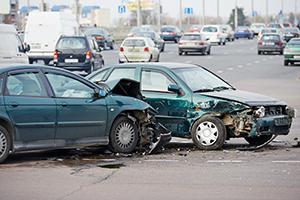Side-Impact Collisions: Understanding the Devastating Impact on the Human Body
Illinois Injury Attorneys for T-Bone Car Accidents
Side-impact collisions, also known as T-bone accidents, are among the most dangerous types of car crashes. In these collisions, the side of a vehicle is struck by another vehicle, often at high speeds, resulting in severe damage and catastrophic injuries. Unlike frontal or rear-end collisions, where the vehicle’s frame provides some protection, the sides of cars typically offer less resistance to the force of an impact, leaving occupants vulnerable to serious injury or even death.
At John J. Malm & Associates, we represent victims of side-impact collisions and understand the devastating effects they can have on the human body. These accidents frequently result in long-term disabilities, chronic pain, and, in the most tragic cases, fatalities. Understanding the biomechanics behind these injuries can help explain why side-impact collisions are so devastating and why they often lead to such severe outcomes.
The Biomechanics of Side-Impact Collisions
In a side-impact collision, the force from the oncoming vehicle is transferred directly to the side of the struck vehicle, which has far less structural protection compared to the front or rear. This leaves occupants vulnerable to absorbing the brunt of the impact. The human body is not designed to withstand these lateral forces, and the sudden, violent motion can cause multiple types of trauma:

- Head and Neck Injuries: In side-impact collisions, the head and neck are often jerked sideways, causing severe injuries such as concussions, traumatic brain injuries (TBI), and whiplash. In more severe cases, spinal cord injuries may result, leading to paralysis or death.
- Catastrophic Head Injuries and Fatalities: The impact of a side collision can cause catastrophic head injuries, including a severed brain stem, which is often fatal. When the head is struck violently or subjected to severe rotational forces, the brain can suffer irreparable damage.
- Chest and Abdominal Injuries: The force of a side-impact crash can crush the torso against the door or interior of the car, causing broken ribs, punctured lungs, or damage to internal organs. These injuries can be life-threatening and require immediate medical attention.
- Pelvic and Hip Injuries: The lower body is also at risk, with the pelvis and hips particularly vulnerable to fractures and dislocations in a T-bone accident.
- Spinal Cord Injuries: The sudden lateral forces can compress or fracture vertebrae, leading to spinal cord damage that may result in long-term disability or paralysis.
Because the human body is not naturally equipped to absorb lateral forces, the risk of severe injury in side-impact collisions is significantly higher than in other types of accidents. This is why side-impact collisions are often associated with higher fatality rates.
The NASCAR Example: How Racing Safety Innovations Can Inform Vehicle Safety
One powerful example of the biomechanical risks of lateral forces can be seen in NASCAR racing. For years, NASCAR drivers were at significant risk of fatal injuries from side-impact crashes during high-speed races. However, in the early 2000s, NASCAR implemented the HANS device (Head and Neck Support) to protect drivers from the intense forces exerted on their bodies during accidents.
The HANS device was specifically designed to prevent the head and neck from snapping violently during crashes, particularly in situations where the car was struck from the side or from angles that caused severe lateral forces. Before the HANS device was widely adopted, NASCAR experienced multiple driver fatalities, including the death of Dale Earnhardt in 2001, which highlighted the urgent need for better protection against these forces.
After the introduction of the HANS device, driver fatalities significantly decreased, demonstrating how proper restraint systems and attention to biomechanics can save lives. While street vehicles are not equipped with the same devices used in racing, this example underscores the importance of understanding how the body responds to lateral forces and improving vehicle safety to mitigate these risks.
Why Side-Impact Collisions Are So Dangerous
The danger in side-impact collisions stems not only from the biomechanical forces involved but also from the limited protection vehicles offer in these types of crashes:
- Lack of Side Protection: Unlike the front and rear of a vehicle, the sides have far less crumple zone space, making it difficult to absorb the force of an impact. Even with the addition of side airbags, the protection offered is minimal compared to other types of collisions.
- Proximity to the Point of Impact: In a side-impact crash, the occupants are much closer to the point of impact, increasing the likelihood of direct contact with the vehicle’s interior or the oncoming vehicle.
- High-Speed Collisions: These accidents often occur at intersections where vehicles are traveling at significant speeds, compounding the severity of the crash.
Case Results: Side-Impact Collisions Leading to Wrongful Death
At John J. Malm & Associates, we have successfully recovered significant settlements for families who have lost loved ones in side-impact collisions:
- $1.5 Million Settlement: Our firm secured a $1.5 million recovery for the wrongful death of a child who was a passenger in a vehicle struck in a side-impact collision at an intersection. A truck failed to stop and struck the vehicle, tragically ending the life of the young passenger.
- $3.9 Million Settlement: We also recovered $3.9 million for the wrongful death of a woman who was fatally injured in a side-impact collision. This case underscores the devastating impact these types of crashes can have on families and loved ones.
Common Causes of Side-Impact Collisions
Side-impact accidents typically occur at intersections, where vehicles are crossing paths. Common causes include:
- Failure to Yield: One of the most frequent causes of side-impact collisions is when a driver fails to yield to the right-of-way, resulting in a T-bone accident at an intersection.
- Running Red Lights or Stop Signs: When a driver runs a red light or stop sign, they may strike another vehicle that is legally passing through the intersection.
- Distracted Driving: Drivers who are distracted by their phones or other activities may fail to notice traffic signals or oncoming vehicles, leading to side-impact crashes.
- Drunk or Impaired Driving: Drivers under the influence of alcohol or drugs are more likely to make poor decisions, such as running lights or failing to yield, which can result in devastating side-impact collisions.
Seeking Legal Help After a Side-Impact Collision
At John J. Malm & Associates, we understand how devastating side-impact collisions can be for victims and their families. If you or a loved one has been injured or killed in a side-impact accident, you may be entitled to compensation for your medical expenses, lost wages, pain and suffering, and other damages. Our experienced DuPage County personal injury attorneys will investigate the accident, gather evidence, and work to ensure that you receive the compensation you deserve.
“Side-impact collisions are particularly dangerous because the human body simply cannot withstand the biomechanical forces involved. Our firm is committed to helping victims of these devastating accidents recover the compensation they need to rebuild their lives.” – John J. Malm
Contact the Illinois Car Accident Attorneys at John J. Malm & Associates for a Free Consultation
If you have been injured in a side-impact collision, contact John J. Malm & Associates today for a free consultation. Our experienced Illinois personal injury attorneys in Naperville and St. Charles are here to help you get the compensation you deserve.















